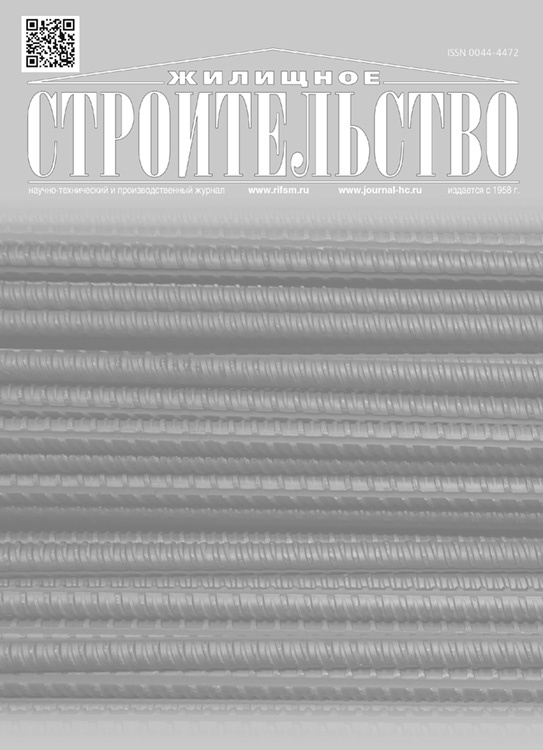Determination of the reliability coefficient by responsibility for the purpose of the architectural monuments structures calculating
- Авторлар: Evseev N.A.1,2, Shashkin V.A.1,2, Shashkin A.G.1,2
-
Мекемелер:
- Institute “Georeconstruction”
- St. Petersburg State University of Architecture and Civil Engineering
- Шығарылым: № 7 (2025)
- Беттер: 3-16
- Бөлім: Articles
- URL: https://medjrf.com/0044-4472/article/view/688653
- DOI: https://doi.org/10.31659/0044-4472-2025-7-3-16
- ID: 688653
Дәйексөз келтіру
Аннотация
Architectural monuments are buildings and structures built mainly a hundred or more years ago, when there were no modern norms for new construction objects. The non-compliance of cultural heritage objects with modern norms in many cases proves to be an obstacle to simultaneously preserving its structures authenticity and ensuring mechanical safety, provoking excessive modern intrusion into the structure historical substance. It is noted that monuments can be classified as a separate type of structures based on a number of characteristics, including structural similarity, the presence of accumulated sediments exceeding the limits regulated by modern norms, the operation duration exceeding the service life according to modern norms, construction in a “pre-regulatory” era based on experience passed down from generation to generation. For such a specific type of structure modern norms allow additional requirements to be considered for the purpose of normative and calculated load values, as well as reliability coefficients. Particular attention is paid to determining the reliability coefficient by responsibility, which is related to ensuring the structures mechanical safety depending on the number of visitors in them. It is shown that ensuring acceptable social risk (which is equivalent to ensuring the required reliability) can be achieved not only by strengthening structural elements but also by limiting the number of visitors to individual premises, which is reflected in the value of the reliability coefficient by responsibility. The dependence allowing to determine the value of this coefficient is proposed. This approach makes it possible to preserve the authenticity of the protected structural elements without compromising the architectural monument reliability.
Толық мәтін
Авторлар туралы
N. Evseev
Institute “Georeconstruction”; St. Petersburg State University of Architecture and Civil Engineering
Хат алмасуға жауапты Автор.
Email: 3763380@gmail.com
Candidate of Sciences (Engineering)
Ресей, 4, Izmailovsky ave., Saint Petersburg, 190005; 4, 2nd Krasnoarmeyskaya Str., Saint Petersburg, 190005V. Shashkin
Institute “Georeconstruction”; St. Petersburg State University of Architecture and Civil Engineering
Email: vashashkin@pi-georeconstruction.ru
Candidate of Sciences (Engineering)
Ресей, 4, Izmailovsky ave., Saint Petersburg, 190005; 4, 2nd Krasnoarmeyskaya Str., Saint Petersburg, 190005A. Shashkin
Institute “Georeconstruction”; St. Petersburg State University of Architecture and Civil Engineering
Email: 9563513@gmail.com
Doctor of Sciences (Geology)
Ресей, 4, Izmailovsky ave., Saint Petersburg, 190005; 4, 2nd Krasnoarmeyskaya Str., Saint Petersburg, 190005Әдебиет тізімі
- Ulitskiy V.M., Shashkin A.G. Preservation of architectural monuments and ensuring their mechanical safety. Promyshlennoe i Grazhdanskoe Stroitel’stvo. 2017. No. 7, pp. 31–39. (In Russian). EDN: ZBTMVB
- Shashkin A.G., Shashkin V.A. Is it possible to ensure the preservation of monuments based on standards for new construction? Geotechnica. 2021. Vol. 13. No. 2, pp. 20–31. (In Russian). EDN: TUKFZN. https://doi.org/10.25296/2221-5514-2021-13-2-20-30
- Tiunov O.V. Rakhmanov: the art of restoration. Saint. Petersburg: Georeconstructsia. 2022. 448 p.
- Shashkin V.A. Accumulated deformations of the historical buildings of St. Petersburg. Zhilishchnoe Stroitel’stvo [Housing Construction]. 2023. No. 12, pp. 32–45. (In Russian). EDN: CITCIO. https://doi.org/10.31659/0044-4472-2023-12-32-45
- Shashkin V.A. The concept of ensuring the mechanical safety of architectural monuments. Promyshlennoe i Grazhdanskoe Stroitel’stvo. 2023. No. 5, pp. 32–39. (In Russian). EDN: POJBBM. https://doi.org/10.33622/0869-7019.2023.05.32-39
- Shashkin V.A., Shashkin A.G. Limited operational technical condition as the norm for architectural monuments. Geotechnica. 2024. Vol. 16. No. 1, pp. 6–22. (In Russian). EDN: ZYDYNN. https://doi.org/10.25296/2221-5514-2024-16-1-6-22
- Ho K., Leroi E., Roberds B. Quantitative risk assessment: application, myths and future direction. Proc. of the International Conference on Geotechnical and Geological Engineering. Melbourne, Australia, 2000. Vol. 1, pp. 269–312.
- Ulitskiy V.M., Lisyuk M.B. Risk assessment and safety in transport construction. Tekhnosfernaya i ekologicheskaya bezopasnost’ na transporte. (TEBTRANS-2012). Proceedings of the III International Scientific and Practical Conference 2012. pp. 245–254. (In Russian). EDN: SYGCHR
- Zhukov I.S., Lisanov M.V. On uniform criteria for acceptable risk at hazardous production facilities. Vesti Gazovoi Nauki. Scientific and Technical Collection. 2022. No. 2 (51), pp. 82–90. (In Russian). EDN: NDVVVM
- Plechkova I.L., Shashkin A.G., Shashkin K.G., Shashkin V.A., Evseev N.A. Ensuring the safety of the foundation of the structures of the Snetogorsky Monastery. Geotechnica. 2020. No. 2, pp. 52–66. (In Russian). EDN: HNOKEP. https://doi.org/10.25296/2221-5514-2020-12-2-52-66
Қосымша файлдар















